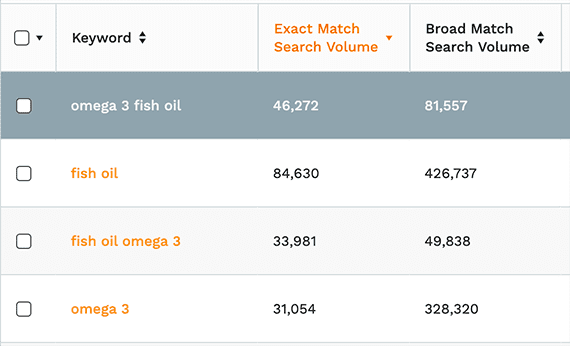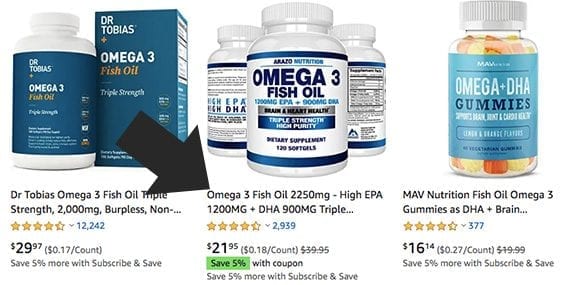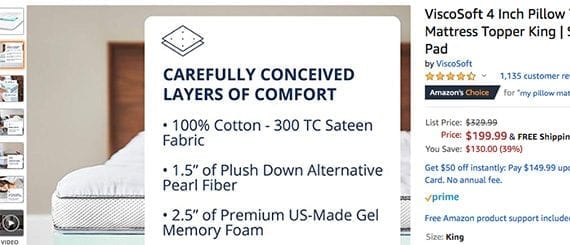On one of the most competitive ecommerce marketplaces in the world, good old-fashioned copywriting could be a key to clicks and conversions for private label brands and trademark holders.
The Amazon marketplace has, perhaps, 5 million third-party sellers. These individuals and enterprises are all competing for ad space, search rankings, and sales. For a subset of these sellers, the ones who have private label brands or control a product page’s title, images, bullet points, and description, there is an opportunity to differentiate.
…good old-fashioned copywriting could be a key to clicks and conversions…
Well written product detail pages can convince an Amazon shopper to buy your business’s mattress topper, omega-3 supplement, or wooden bocce set — instead of your competitors’.
Here are some tips to improve your company’s Amazon product pages.
Keywords
Search optimization for Amazon is not the same as search optimization for Google, Bing, or other search engines. Some might argue that Amazon’s search algorithms are somewhat less sophisticated. Where Google might recognize a keyword anywhere in a page title for ranking purposes, Amazon could favor a product listing’s title that begins with the target keyword phrase.
Thus it can be a good idea for some categories to put your primary keywords first in your product title.
“Where you put a word in a product title has a significant impact on your [Amazon] ranking,” said Leland Taylor, vice president and managing partner at Brand Buddy, a retail and ecommerce customer experience firm based in Los Angeles, Calif.
“Many people put their brand name first in the title,” said Taylor, but “if I take out your brand name…if I drop that — because your brand name is already there (right below) as the seller — you can move your primary keyword forward which might have the highest search volume.”
“I often explain that as like an aisle,” said Taylor. “You have an aisle, let’s say for my omega-3s, you’re walking down. You’re looking for it. That product title will rank you better.”
Here the best option may be to use a tool such as Jungle Scout’s Keyword Scout, which estimates how many monthly exact-match and broad-match searches a particular keyword phrase receives. If your business knows that “omega 3” gets 31,000 exact-match searches and “fish oil” receives 84,000, it may make sense to put the latter at the beginning of the product’s title.

Where a keyword is positioned in an Amazon product title can impact how well it ranks for a given Amazon search. Researching Amazon keywords can help. This example uses Jungle Scout’s Keyword Scout.
Product Benefits
Taylor also recommends putting some of your product’s benefits directly in the product title.
Continuing with the omega-3 supplement example, Taylor argues that most titles are “a sea of sameness,” listing things like milligrams of EPA and DHA (two nutritional components) that are often identical from supplement to supplement.

A product will not likely stand out if its title is too similar to the competition, such as these titles for omega-3 fish oil.
Consider this example: “Omega 3 Fish Oil 2250mg – High EPA 1200MG + DHA 900MG Triple Strength Burpless Capsules.”
A seller may be able to improve the number of clicks, particularly from mobile search-result pages, by including a benefit statement, such as: “Fish Oil, Omega 2 – Improves Brain Health, Reduces Heart Attack Risk Factors – 2250mg, 120 Count.”
Text in Graphics
There are relatively few opportunities to distinguish your company’s products from your competitors’ on the Amazon marketplace. So don’t waste them.
“One of those [opportunities] that sellers often miss is images,” Taylor said. “Sellers forget that on your images you can add copywriting. You can do comparison charts. You can do benefit callouts or feature callouts and sell through the power of images, which is huge when it comes to conversion.”
“You can also add things like trust symbols. You can add your guarantees or assurances that you’re environmentally friendly.”
The aim is not to turn the product image section on the detail page into a slide presentation, but rather to communicate what makes your products worth buying.
ViscoSoft, as an example, does this with its four-inch mattress topper. Several of the product images include marketing copy. This copy varies from a description of the products “carefully conceived layers of comfort” to its 60-day return policy.

A mattress topper might not be much to look at. Including copy on the image can help.
As a rule for Amazon product description graphics, if a callout, an arrow, or sales copy would boost conversions, add it. Don’t be afraid to also include this same information in your bullet points and product description, since the copy on images is not accessible via a screen reader.
Bullet Points, Descriptions
The bulleted list of specifications found on Amazon product detail pages is not the place for boring, matter-of-fact copy.
Taylor suggests calling out benefits and selling urgency with your bullet points and product descriptions.
Amazon shoppers have commercial intent. Folks searching on Google may be looking for information, but on Amazon, they are all shoppers.
When we shop on Amazon, Taylor explained, “We’re in kind of a slushy, emotional state of what’s called ‘high commercial intent.'”
Amazon shoppers can experience joy or a buzz when they contemplate a purchase. A copywriter should recognize this state and “sell” the product, calling out its benefits and the urgency of completing the transaction. This should be done with visual language, examples, and storytelling.
Taylor suggests returning to the roots of advertising copywriting. Search for a list of “classic advertising hooks” and try to include one or two in your product description.






